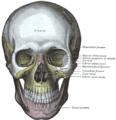Human mandible
This article includes a list of references, related reading, or external links, but its sources remain unclear because it lacks inline citations. (June 2008) |
| Mandible | |
|---|---|
 Mandible. Outer surface. Side view | |
 Mandible. Inner surface. Side view | |
| Details | |
| Precursor | 1st branchial arch[1] |
| Identifiers | |
| Latin | mandibula |
| Anatomical terms of bone | |
The mandible (from Latin mandibula, "jawbone") or inferior maxillary bone forms the lower jaw and holds the lower teeth in place. It also refers to both the upper and lower sections of the beaks of birds.
Components
The mandible consists of:
- a curved, horizontal portion, the body. (See body of mandible).
- two perpendicular portions, the rami, which unite with the ends of the body nearly at right angles. (See ramus mandibulae)
- Alveolar process, the tooth bearing area of the mandible (upper part of the body of the mandible)
- Condyle, superior (upper) and posterior projection from the ramus, which makes the temporomandibular joint with the temporal bone
- Coronoid process, superior and anterior projection from the ramus. This provides attachment to the temporalis muscle
Foramina (singular=foramen)
- Mandibular foramen, paired, in the inner (medial) aspect of the mandible, superior to the mandibular angle in the middle of the ramus.
- Mental foramen, paired, lateral to the mental protuberance on the body of mandible.
Nerves
Inferior alveolar nerve, branch of the mandibular division of Trigeminal (V) nerve, enters the mandibular foramen and runs forward in the mandibular canal, supplying sensation to the teeth. At the mental foramen the nerve divides into two terminal branches: incisive and mental nerves. The incisive nerve runs forward in the mandible and supplies the anterior teeth. The mental nerve exits the mental foramen and supplies sensation to the lower lip.
Articulations
The mandible articulates with the two temporal bones at the temporomandibular joints
Pathologies
One fifth of facial injuries involve mandibular fracture.[2] Mandibular fractures are often accompanied by a 'twin fracture' on the contralateral (opposite) side.
Aetiology

- Motor vehicle accident (MVA) - 40%
- Assault - 40%
- Fall - 10%
- Sport - 5%
- Other - 5%
Location
- Condyle - 30%
- Angle - 25%
- Body - 25%
- Symphesis - 15%
- Ramus - 3%
- Coronoid process - 2%
The mandible may be dislocated anteriorly (to the front) and inferiorly (downwards) but very rarely posteriorly (backwards).
See also
- Bone terminology
- Terms for anatomical location
- Changes produced in the mandible by age
- Ossification of the mandible
- Oral and maxillofacial surgery
Additional images
-
Front
-
Mandible
-
Gray181.png
-
Facial bones
-
Side view of the skull.
-
The skull from the front.
-
The veins of the neck, viewed from in front.
References
- ^ hednk-023—Embryo Images at University of North Carolina
- ^ Levin L, Zadik Y, Peleg K, Bigman G, Givon A, Lin S (2008). "Incidence and severity of maxillofacial injuries during the Second Lebanon War among Israeli soldiers and civilians". J Oral Maxillofac Surg. 66 (8): 1630–3. doi:10.1016/j.joms.2007.11.028. PMID 18634951. Retrieved 2008-07-16.
{{cite journal}}: Unknown parameter|month=ignored (help)CS1 maint: multiple names: authors list (link)
External links
- Anatomy photo:34:st-0203 at the SUNY Downstate Medical Center – "Oral Cavity: Bones"
- Diagram at uni-mainz.de
![]() This article incorporates text in the public domain from the 20th edition of Gray's Anatomy (1918)
This article incorporates text in the public domain from the 20th edition of Gray's Anatomy (1918)







